On test: 300hp New Holland is best T7 yet with fresh cab
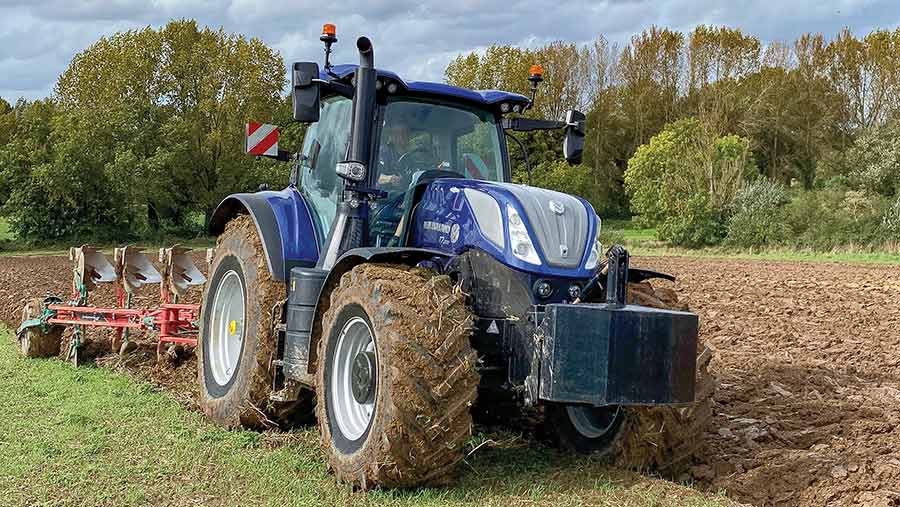 © MAG/Oliver Mark
© MAG/Oliver Mark New Holland has kept the best bits and reworked the worst of its long-wheelbase T7 tractors to create what it hopes will be a John Deere and Fendt slayer.
In a nutshell, that means the generally reliable and economical FPT engine remains in situ, the transmission has been subject to some subtle jiggery-pokery, and the old cab has been superseded by something strikingly smarter.
See also: Driver’s view: Robert Cross rates his New Holland T7.315
The new Horizon Ultra setup has been gradually wicking down the CNH product line after debuting on the bigger T8s and T7 HDs and is far more luxurious than anything to have rolled out the Basildon factory until now.
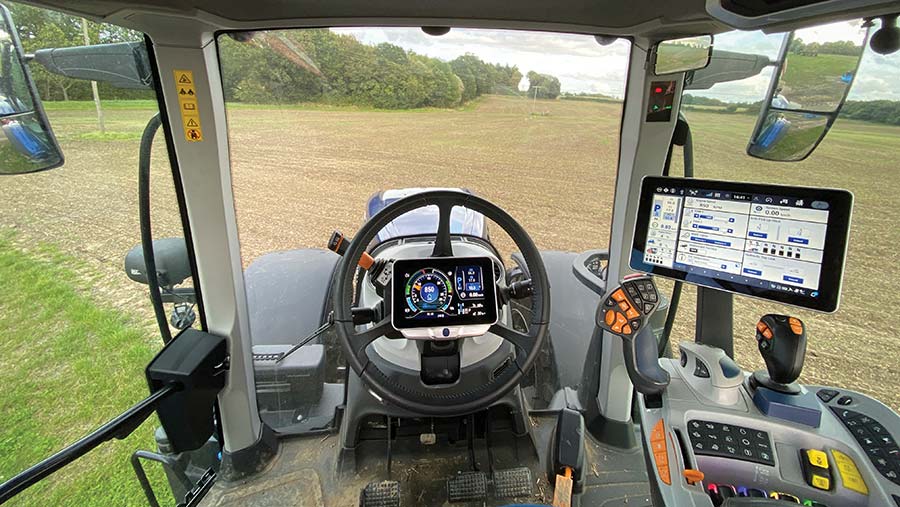
© MAG/Oliver Mark
There’s also a new model at the summit of the now five-strong long-wheelbase line-up – the T7.300.
New Holland T7.300
- Engine 6.7-litre, six-cylinder FPT
- Max/boosted power 280/300hp
- Boosted torque 1,249Nm @1,300rpm
- Transmission AutoCommand CVT
- Lift capacity 10.5t rear, 5.9t front
- Hydraulics 170 litres/min, five rear spools
- Wheelbase 2.89m
- Turning circle 12.2m
- Minimum weight 8.9t
- Gross vehicle weight 15t
- List price £257,426
- Approximate on-farm price £181,000
Market forces seem to be converging on the 300hp sector, where the perennial upward drift of average tractor horsepower is colliding with a downdraught from those moving away from ultra-heavy crawlers.
In the UK, at least, that makes the 250-300hp bracket particularly keenly contested.
What’s new in the cab?
Pretty much everything, but it’s not immediately obvious from afar. Although the frame is 7.5% bigger, its silhouette is akin to the old version, pinching in as it rises roofwards.
As a result, it doesn’t feel quite as bright as Deere’s 6R 250 and it can’t compete with the Fendt 828 for outright cubic capacity.
But it is high, and the exhaust is hidden almost entirely by the pillar, which keeps the front vista clear and the views outwards pretty good.
It also frees more space under the fenders for big tyres on 48in rims.
The first clue to the revolution inside comes before the operator’s backside meets the seat.
Most long-wheelbase T7s will be delivered with fob-based central locking and push-button start, which is currently optional but earmarked to become standard.
One gizmo can be programmed to unlock and mobilise up to five tractors and, should it be lost, operators can punch a six-digit pin into the touchscreen to get the tractor started.
By New Holland’s reckoning this should make the tractors more secure but, for beleaguered Range Rover owners in the South East, keyless entry has been less blessing and more curse.
Time will tell whether it’s a useful improvement or an unnecessary complication.
Changes inside the cab are equally radical and long overdue. The old version, uninspired and tired after two decades’ service, was generally held in dim repute.
But the worst of it – the scratchy plastics, old-school controls and a colour scheme that drifted between the hospital corridor hues of grey and blue – is now gone.
Instead, svelte fabric lines the ceiling, cool air is fired from chi-chi vents and the trims fit with Scandinavian snugness – ironic given it is far better in this regard than the Finnish-built Valtras.
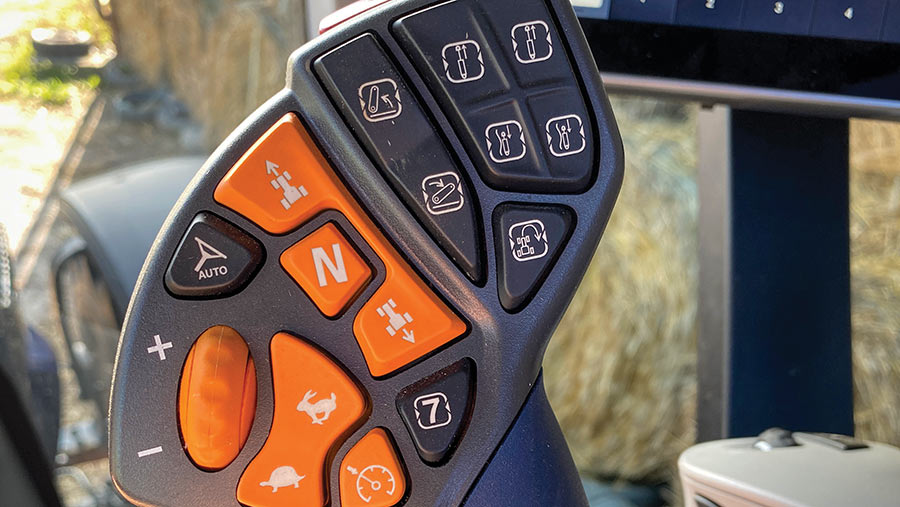
© MAG/Oliver Mark
Higher-spec Blue Power models are further embellished with, among other things, a leather seat and carpet on the inside, and extra worklights outside.
That said, we felt the lighting package underdelivered; rear-facing spotlights need to reach further and wider, and those above the A-pillar are partly obstructed by the wing mirror arms.
Controls of different shapes and sizes – blister buttons, luminescent paddles and notched rollers – are spread banquet-like across a busy armrest now provided by the same supplier as Fendt.
But the stand-out feature is the second (optional) screen imbedded in the centre of the steering wheel.
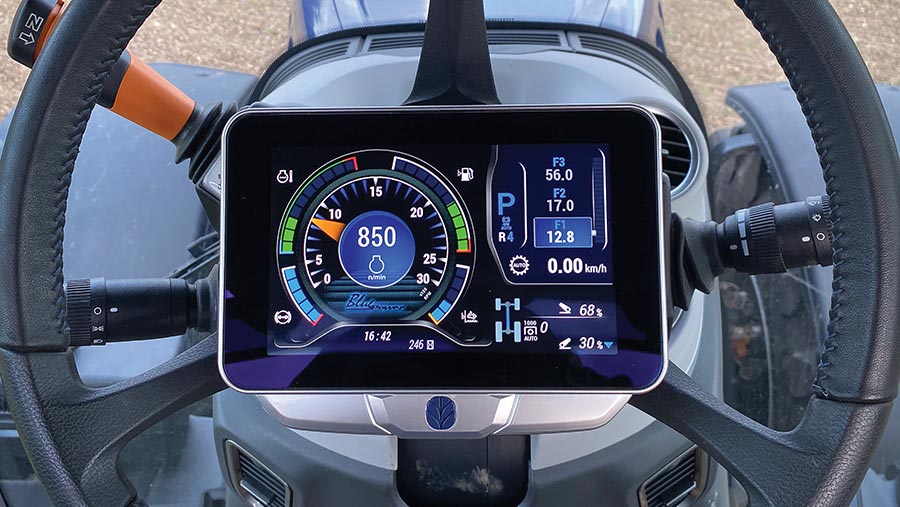
© MAG/Oliver Mark
Quite what it offers, beyond its ability to display a feed from an external camera, isn’t obvious, as it simply shows digital read-outs that would otherwise be presented on a standard dash or, a la stablemate Case IH, on the cab pillar.
It doesn’t fall into the driver’s line of sight either, can’t yet be programmed to show guidance maps, and gets in the way when spinning the wheel in a hurry.
Away from the visual stuff, there has been a marked hushing of the engine, with wodges of cladding and cushioned cab mounts stifling in-cab noise to a market-leading 66dB.
That represents a 4dB advance on the old model, which was already civilised – aside from its whiny transmission (more on that later).
Is it complicated?
The answer to this depends entirely on your attitude to touchscreens.
There are far more functions and fewer physical controls, which inevitably forces operators to wade through the 12in Intelliview on a regular basis.
Fortunately, the system is arranged in a format not unlike John Deere’s, which makes it relatively easy to find settings and tweak the layout of displays.
But the software is more ponderous; it takes a minute or two to wake up and suffers from momentary pauses as it processes relatively simple requests.
The way it works is largely unchanged, with seven separate displays – “run screens” in New Holland parlance – that operators can curate to their liking and subsequently toggle between.
For the first time, it’s possible to show both isobus implement controls and GPS simultaneously, it can be paired with a smartphone to answer calls and play tunes, and it can be combined with a wifi camera (£1,189).
This can be fitted on a combine spout, for example, with the feed popping up on the Intelliview screen once the tractor is in range to help fill grain trailers efficiently.
The screen also displays clutch pressure and steering angle sensor voltage – potentially allowing operators to do some basic diagnostics without the cost implications of calling out a laptop-wielding engineer.
One other change of note relates to the receiver, which is now provided by Novatel; CNH’s acquisition of Raven having complicated the firm’s previous arrangement with Trimble.
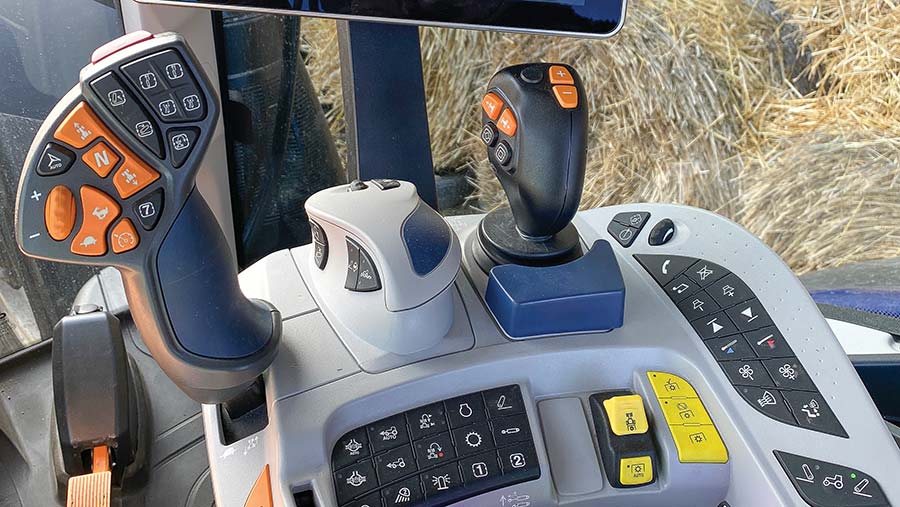
© MAG/Oliver Mark
Same engine, tweaked transmission
New Holland has stuck with the established 6.7-litre FPT engine that is still held in high regard.
The turbocharged six delivers 280hp, or 300hp when boosted, which translates to a power-to-weight ratio of 28.3kg/hp.
That gives the T7.300 plenty of thump for its size, particularly when compared with the middle model in the range above, the 315 HD (34kg/hp).
Minor tweaks specific to the T7.300 include a bigger SCR chamber, cooling pack and fan, plus an electronic variable-geometry turbo.
The diesel tank has also grown by 65 litres to 465, the engine oil is now on a 750-hour schedule and the crankcase breather has been moved out of the rocker cover to simplify maintenance.
The transmission has undergone more extensive surgery to smoothen gear shifts and reduce the irritating whine of the old models.
It still works in the same way, with four physical mechanical ranges controlled in the cab as three adjustable speed limits that top out at 56kph.
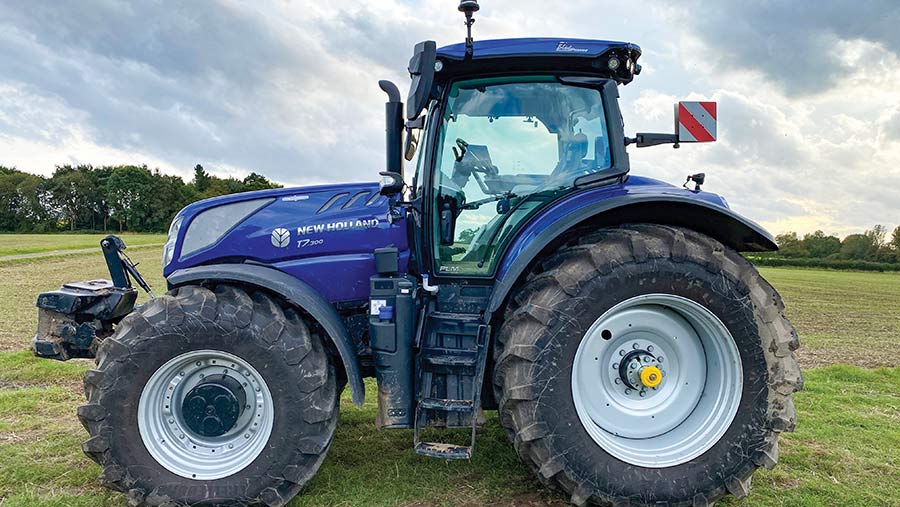
© MAG/Oliver Mark
But where before operators could feel and hear it shuffle though those ranges, the process is now imperceptible thanks to more refined gear cuts and a bigger piston accumulator that provides extra damping.
There are some new features too, chief of which is a “kick-down” mode that allows the engine to ascend quicker to peak power and deliver sprightlier acceleration.
The T7s also get CNH’s intelligent trailer braking system, which engages the implement’s pneumatic brake to avoid the tractor getting pushed when decelerating downhill.
Allied to that is the exhaust brake, which can be set to work automatically with the pedals or engaged via a foot switch on the cab floor.
This ramps up the output of the turbo, forcing more air into the engine to provide more retardation and reduce the strain on the tractor’s brakes.
Terraglide suspension of the beefed-up front axle is standard across the board, and it can be paired with semi-active Comfort Ride cab suspension (a £3,043 option).
We found the latter was best set to “hard” in the touchscreen, given the tractor was shod on VF tyres – 650/85 R38s – at a relatively low field work pressure.
Their flexible sidewalls allow for plenty of lateral movement that means the suspension system is effectively trying to balance the cab on a plate of jelly.
In the softest setting, this leaves it bobbing and swaying rather unnervingly.
Likes and gripes
Likes
- Car-like finish
- Whisper-quiet in the cab
- Screen surprisingly simple to navigate
- Torquey and generally reliable engine
Gripes
- Slow screen software
- Underwhelming lighting package
- Cab still feels on the small side
Backend and hydraulics
Bare weight of the T7.300 is 8.9t – 600kg less than its peers in the Fendt and John Deere stables – while maximum gross vehicle weight is 15t.
This provides only modest capacity for ballast that can offset some of the weight on the 10.5t-capacity rear linkage.
The way the lift arms are controlled has changed drastically, with a scroller for quick, temporary depth or draft adjustments on a computer mouse neighbouring the joystick.
A second notched wheel halfway along the armrest is used to make permanent alterations to depth, drop speed and the like.
Once the initial confusion has subsided it becomes surprisingly easy to operate and saves having to fit a second joystick dedicated to the front linkage.
The tractor also comes with hydraulic linkage stabilisers, allowing the point at which they switch from rigid to floating to be altered without leaving the cab.
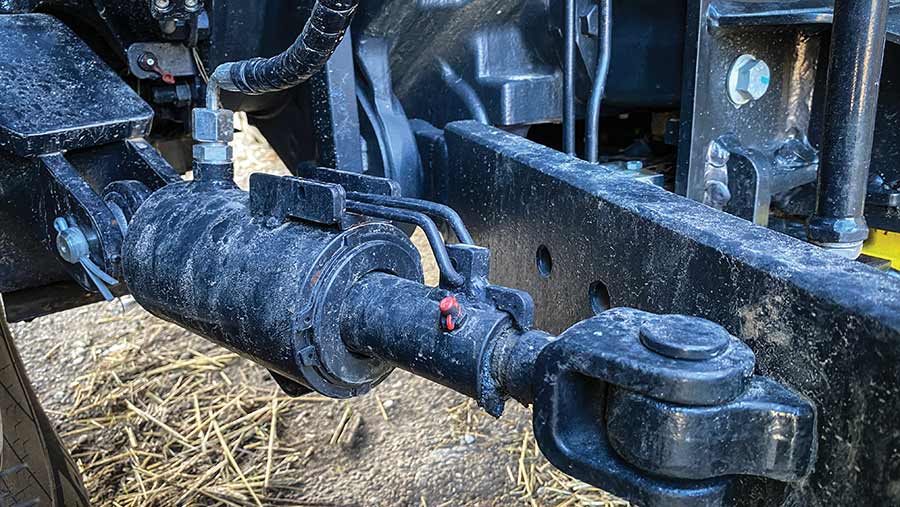
© MAG/Oliver Mark
A 170-litre/min hydraulic system feeds five spools – now provided by Bosch – that can be reassigned to different colour-changing paddles in the cab.
The powered top link is hard piped directly into the block to free up the fifth connection, and both it and the telescopic pick-up hitch can be set up to work on one of the eight programmable armrest buttons.
One new addition is “big baler mode”, which cleverly learns the timing of the plunger stroke of any isobus-ready CNH baler built after 2018.
Doing so allows it to pre-inject the engine cylinders with a small amount of diesel immediately before the plunger wallops the crop to provide a bit more power.
This reduces engine speed variation by a claimed 26% and, says New Holland, increases output without affecting fuel consumption.
The 300 was also the first New Holland model to get tractor implement management, allowing the baler or forage wagon to determine forward speed and automatically work a hydraulic valve without any operator input.
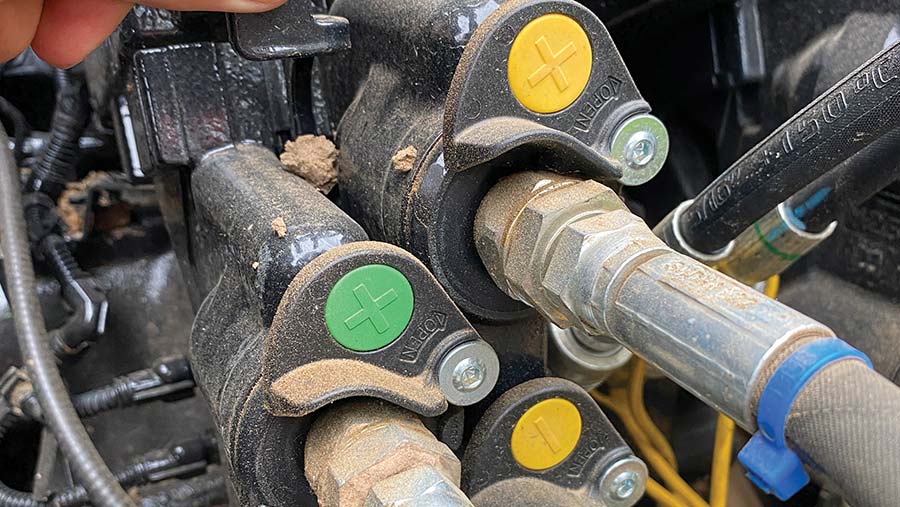
© MAG/Oliver Mark
Other updates that warrant a mention include two memory settings for the lights – one for field and another for road, accessed by hot keys on the armrest – and controls on the rear fender that allow operators to flick between a pair of engine speeds when pumping slurry from a lagoon.
Farmers Weekly verdict
Nice cabs are nothing new – John Deere and Fendt have been knocking them out for years in this power category – but the addition of the Horizon Ultra significantly strengths New Holland’s hand.
It might add an unnecessary expense in the eyes of some buyers, but the improvements undoubtedly make the new T7.300 an intriguing proposition for anyone previously wedded to green-liveried rivals.
Interestingly, it’s also yet another sign that most of the mainstream tractor manufacturers are now capable of offering the sort of fit and finish that was once exclusively Fendt territory, making the 300hp power bracket more competitive than ever.
However, there’s an inevitable price to pay for the niceties.
Based on a like-for-like version of the T7.270, the previous top dog, buyers can expect to be relieved of an extra 4% – about £10,000.
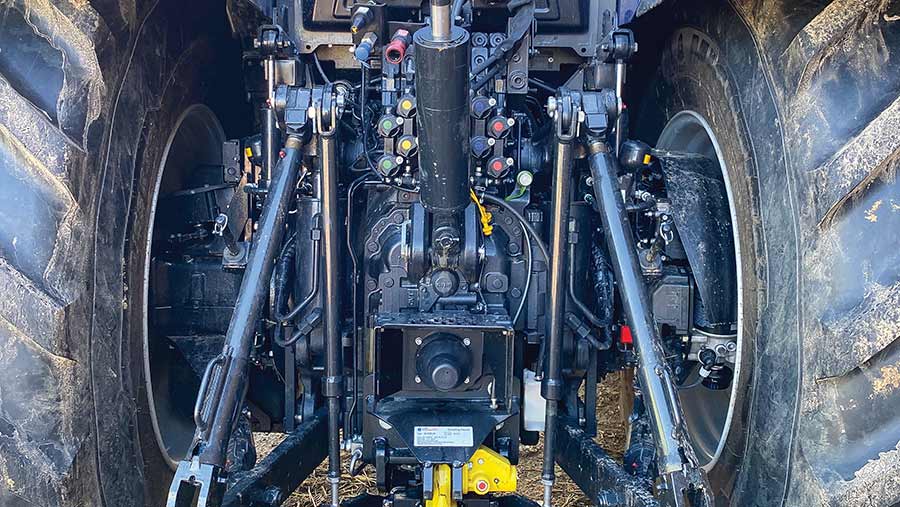
© MAG/Oliver Mark
The range
New Holland’s six-cylinder T7 range is split in half, the lower end of which contains short-wheelbase models that run from the 165hp T7.165 to the 200hp (225hp boosted) T7.225. These are yet to receive the new cab.
The long-wheelbase line-up now starts with the 230 (200hp max/225hp boosted) and includes the 245 (220/245hp), 260 (240/260hp), 270 (260/270hp) and the 300 (280/300hp) featured here.
These are propelled by the same 6.7-litre engine, and all but the top two are available with a full powershift transmission as an alternative to the AutoCommand CVT.
Deliveries for these models started in early April. Most were range-topping 300s, which will inevitably be the biggest seller.
There is a small overlap with the larger T7 HDs. A rejig last year saw the 273hp T7.275 HD dropped, effectively to accommodate the T7.300.
This leaves the 288hp T7.290 HD and 313hp 315, which were joined by the new flagship 340 that debuted at Cereals in June.

